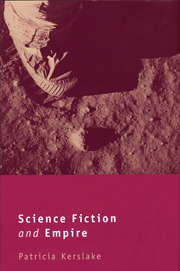Book contents
- Frontmatter
- Contents
- Introduction
- 1 The Self and Representations of the Other in Science Fiction
- 2 Resistance Is Futile: Silencing and Cultural Appropriation
- 3 The Word for World Is Forest: Metaphor and Empire in Science Fiction
- 4 Things Fall Apart: Relativity, Distance and the Periphery
- 5 Moments of Empire: Perceptions of Lasswitz and Wells
- 6 Exoticising the Future: American Greats
- 7 The Shape of Things to Come: Homo futuris and the Imperial Project
- 8 A Postcolonial Imagination: Kim Stanley Robinson's Mars
- 9 Beyond Empire: Meta-empire and Postcoloniality
- Conclusion
- Notes
- Bibliography
- Index
6 - Exoticising the Future: American Greats
- Frontmatter
- Contents
- Introduction
- 1 The Self and Representations of the Other in Science Fiction
- 2 Resistance Is Futile: Silencing and Cultural Appropriation
- 3 The Word for World Is Forest: Metaphor and Empire in Science Fiction
- 4 Things Fall Apart: Relativity, Distance and the Periphery
- 5 Moments of Empire: Perceptions of Lasswitz and Wells
- 6 Exoticising the Future: American Greats
- 7 The Shape of Things to Come: Homo futuris and the Imperial Project
- 8 A Postcolonial Imagination: Kim Stanley Robinson's Mars
- 9 Beyond Empire: Meta-empire and Postcoloniality
- Conclusion
- Notes
- Bibliography
- Index
Summary
While the history of SF may arguably stretch back to the fables of the ancient Greeks, one of the first conventionally recognised speculative narratives was Sir Thomas More's Utopia (1516), which describes the travels of a Portuguese sailor, Raphael Hythloday, and the controversial but wondrous socio-political climate on the island of Utopia in the New World. Following this, but written for different reasons, came a work by the pantheist martyr Giordano Bruno, De l'Infinito universo e mondi (1584), which argued that the universe was infinite and that it contained an infinite number of worlds, all inhabited by intelligent beings. Bruno's text is credited by Frances Yates as being the origin of Hermetic influence on science, since it involved magical interpretations of nature and of humanity's ability to conjure and understand the world, philosophical aspects that dovetail pleasingly with some perceptions of today's science and technologies.
More's and Bruno's works may be considered an excellent genesis of a genre unlike anything that had been experimented with before: not conventional literature, not scientific or parable, nor yet historical or plainly political, but a creative amalgam of all, a blend of the rational and the extrapolative, bound together with a touch of sixteenth-century optimism.
- Type
- Chapter
- Information
- Science Fiction and Empire , pp. 105 - 126Publisher: Liverpool University PressPrint publication year: 2010



